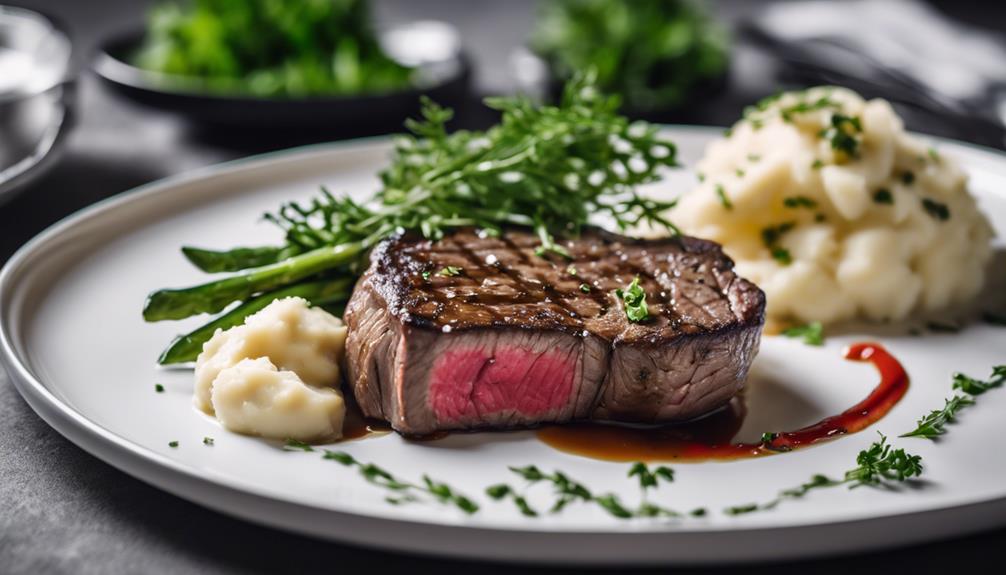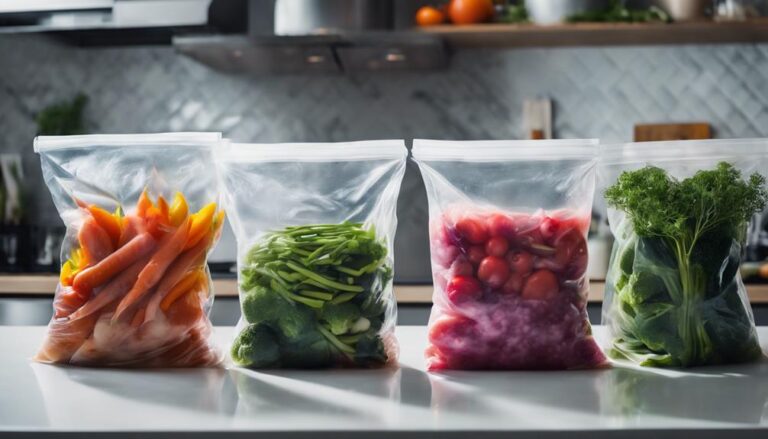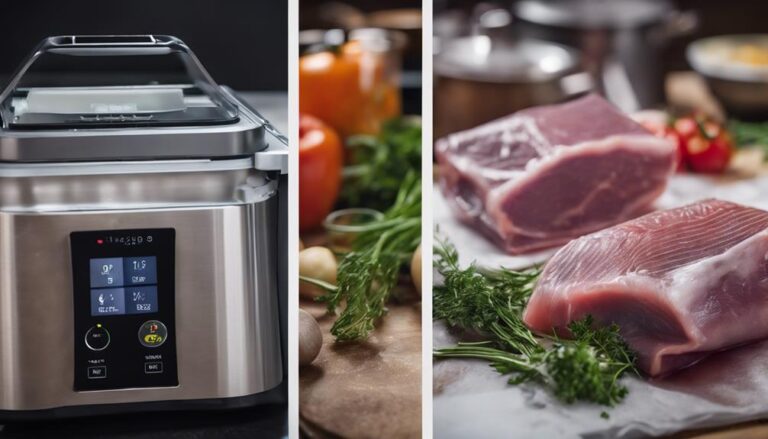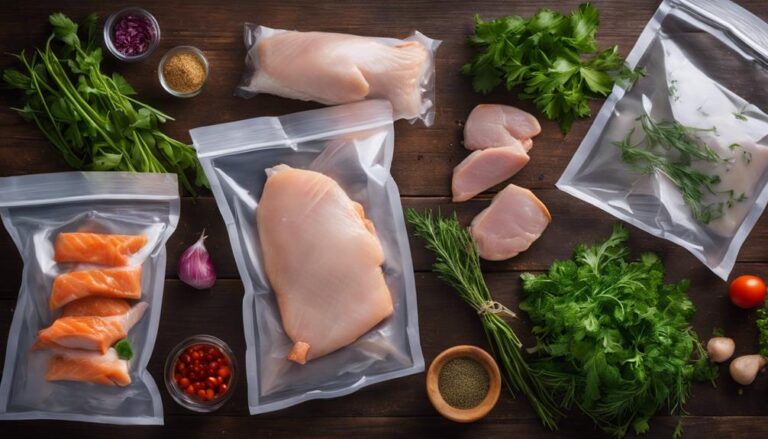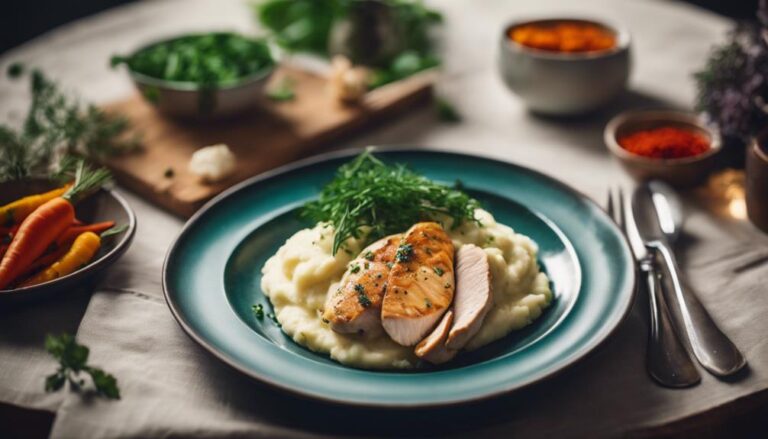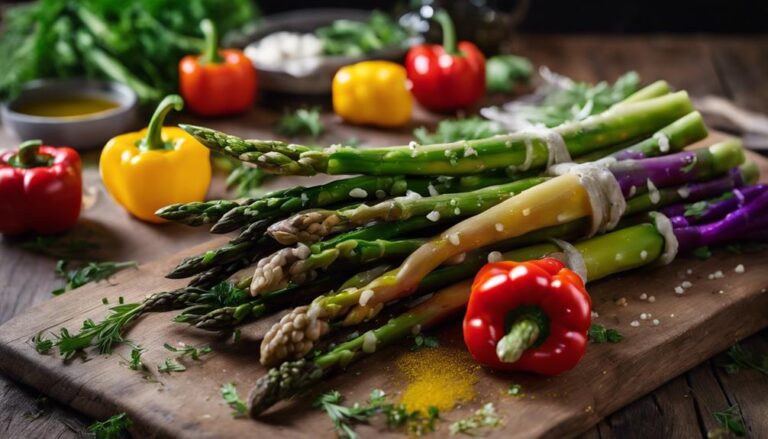Portion Control With Sous Vide: Perfectly Sized Meals
Portion control with sous vide simplifies meal preparation and helps you create perfectly sized meals. By vacuum sealing your food and cooking it at precise temperatures, you retain moisture and enhance flavor. This method allows you to portion out ingredients to prevent overeating and reduce food waste. You can plan your meals ahead of time, making it easier to track calories and nutritional values. Choosing the right cuts of meat and using proper seasoning techniques also boosts your culinary experience. As you explore this cooking style, you'll discover more tips to maximize your meals and cooking enjoyment.
What You Will Learn Here
- Sous vide cooking allows for precise portion control by preparing meals in uniform sizes, ensuring consistent doneness and flavor.
- Vacuum sealing eliminates air and prevents freezer burn, enhancing the quality and shelf life of portioned meals.
- Cooking tough cuts of meat at low temperatures tenderizes them, making portions more satisfying and flavorful.
- Quick chilling after cooking maintains meal quality and safety, enabling efficient freezing for later use.
Understanding Sous Vide Basics
Sous vide cooking is all about sealing your food in airtight bags and gently immersing it in a water bath at a precise temperature for perfectly even results. This innovative technique allows you to master portion control while meal planning.
By focusing on cooking time and temperature, you can achieve consistent doneness, regardless of the food's quantity. Whether you're cooking a steak or a vegetable medley, the thickness of the food is what primarily determines the cooking duration.
Vacuum sealing is essential in this process, as it eliminates air and prevents freezer burn, ensuring your meals last longer without compromising quality. The moisture retention that sous vide provides enhances the flavor and texture of your dishes, making even the least expensive cuts of meat deliciously tender.
Moreover, sous vide cooking considerably improves food safety. When you cook at the right temperature for the appropriate time, you pasteurize your food, which reduces the risk of foodborne illnesses.
Understanding these basics of sous vide will empower you to create perfectly sized meals that aren't only tasty but also safe and efficient for your lifestyle.
Benefits of Portion Control
Mastering portion control through sous vide cooking not only helps you maintain a balanced diet but also prevents overeating and reduces food waste. Sous vide enthusiasts appreciate the ability to cook individual portions with precision, ensuring each meal aligns with your dietary goals.
By using vacuum-sealed bags, you can easily track caloric intake and nutritional values, making it simpler to adhere to your meal planning strategy. When meals are portioned accurately, it's easier to prepare ready-to-eat meals that fit into your busy lifestyle. This method allows you to create meals in the exact amounts needed, minimizing leftover food that often goes to waste.
Research shows that practicing portion control promotes effective weight management, reinforcing the idea that portion sizes play a fundamental role in healthy eating habits.
With sous vide cooking, you're not just preparing meals; you're creating a sustainable approach to eating. Embracing portion control empowers you to take charge of your nutrition while enjoying the benefits of perfectly sized meals. This innovative technique not only enhances your culinary experience but also supports a healthier lifestyle.
Bulk Meal Prep Process
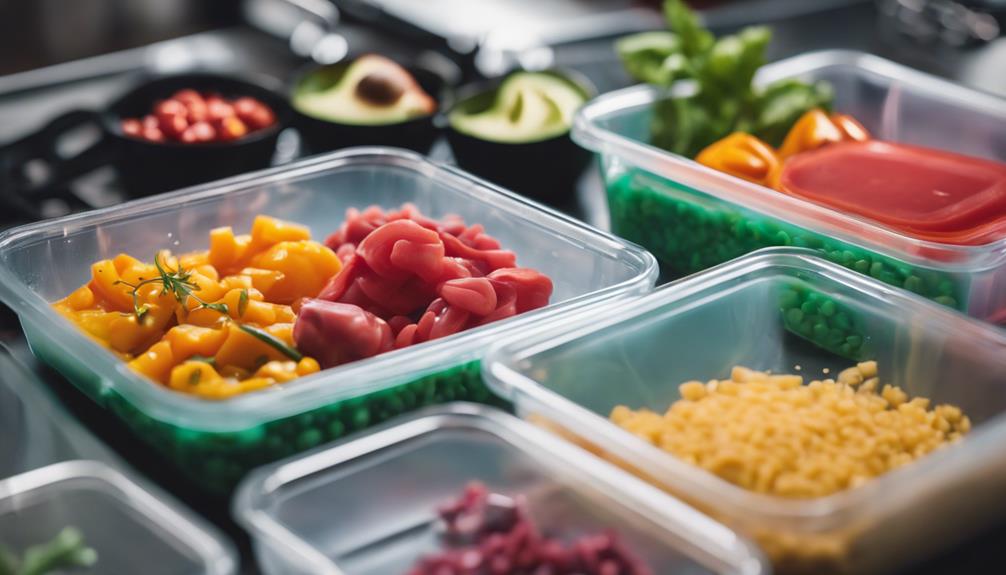
Bulk meal prep for sous vide cooking lets you save money and time while guaranteeing that you have perfectly portioned meals ready for your busy schedule. By engaging in bulk cooking, you can buy meat in larger quantities, reducing packaging waste and cutting costs. Start by cutting the meat into desired portion sizes and seasoning them with your favorite herbs or spices. Then, use a vacuum sealer to pack each portion into sous vide bags for maximum freshness.
Here's a simple table to visualize the bulk meal prep process:
| Step | Action | Purpose |
|---|---|---|
| 1. Portioning | Cut meat into portions | Guarantee portion control |
| 2. Seasoning | Add spices/herbs | Enhance flavor |
| 3. Vacuum sealing | Seal in sous vide bags | Preserve freshness |
You can choose to cook the meat immediately and then freeze it or freeze the raw portions to cook later. Remember to employ quick chilling after cooking to maintain quality and safety. This method streamlines meal planning and guarantees you always have delicious, ready-to-eat meals on hand.
Selecting the Right Meat
Choosing the right meat is key to guaranteeing your sous vide meals turn out flavorful and tender.
When selecting the right meat, consider opting for tougher cuts like brisket or chuck roast, as they become incredibly tender through the low-and-slow cooking process. These cuts not only offer rich flavors but also provide excellent value. Fresh, quality meats are essential; always procure from reputable sources to assure the best taste and texture.
Pay attention to the thickness of cuts, too. Sous vide cooking relies on thickness rather than weight, so aim for cuts that are at least 1 inch thick. This guarantees they reach the desired doneness while allowing for longer cooking times to break down tough fibers effectively.
Additionally, look for meats with a good fat-to-meat ratio. The fat enhances moisture and flavor, leading to perfectly cooked meals that are succulent and satisfying.
Seasoning Techniques for Flavor
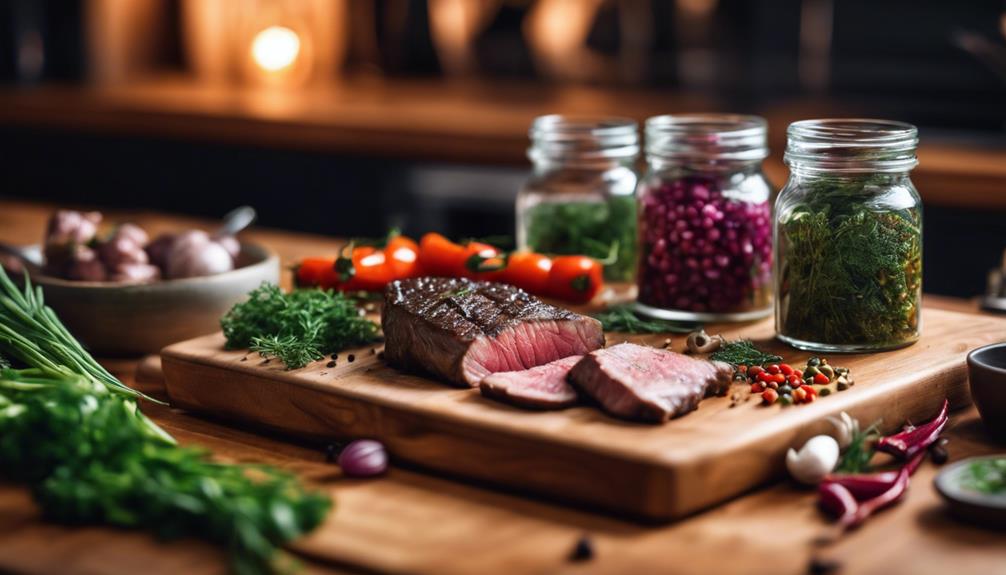
When seasoning for sous vide, using spice rubs and blends can greatly enhance the flavor of your meat.
You can also add fresh herbs to your sous vide bag, which not only infuses the dish with vibrant tastes but elevates simple meals to gourmet levels.
Spice Rubs and Blends
Spice rubs and blends can transform your sous vide meats, infusing them with a depth of flavor that elevates every bite. By carefully selecting and combining spices, you'll create customized seasoning that enhances your dishes. Here are some ideas to inspire your next sous vide meal:
- Classic BBQ Rub: Mix brown sugar, paprika, garlic powder, and black pepper for a smoky sweetness.
- Citrus Zest Blend: Combine lemon zest, orange zest, and a hint of chili powder for a revitalizing kick on fish.
- Coffee-Based Rub: Create a robust flavor profile for beef by blending ground coffee, salt, and cayenne pepper.
To achieve ideal flavor infusion, season your meat with spice rubs at least 30 minutes before vacuum sealing. This allows the spices to penetrate the meat effectively.
After preparing your spice blends, store them in airtight containers to prolong their shelf life and maintain vibrant flavors for your future sous vide meals.
Embrace the power of spice rubs to innovate your culinary creations!
Fresh Herbs Enhancements
Fresh herbs can elevate your sous vide dishes by infusing them with vibrant flavors and aromatic qualities that enhance your culinary experience. When you add fresh herbs to your sous vide bags, you're not just seasoning; you're transforming the entire flavor profile. The essential oils and moisture in fresh herbs are preserved during the low-temperature cooking process, ensuring a robust taste that dried herbs simply can't match.
To maximize flavor, consider bruising or chopping your herbs before adding them. This technique releases more essential oils, providing a richer taste. Pairing the right herbs with specific proteins can also heighten your dish's appeal. For instance, dill complements salmon beautifully, while sage enhances pork dishes.
Here's a quick reference table to guide your herb selections:
| Protein | Complementary Herb | Flavor Enhancement |
|---|---|---|
| Chicken | Thyme | Earthy, aromatic flavors |
| Beef | Rosemary | Bold, savory undertones |
| Fish | Dill | Fresh, bright notes |
| Pork | Sage | Warm, comforting essence |
Incorporate these fresh herbs into your cooking process and watch how they enhance taste and elevate your meals.
Proper Bagging Methods
Using vacuum-sealed bags is crucial for sous vide cooking, as they remove air to prevent oxidation and maintain food quality. Proper bagging methods enhance your cooking experience and guarantee safety.
Here are key points to keep in mind:
- Uniform sizes: Cut your proteins into uniform sizes for even cooking, ensuring consistent doneness throughout the meal.
- BPA-free materials: Use bags specifically designed for sous vide cooking, like BPA-free plastic or silicone, to withstand high temperatures safely.
- Avoid overcrowding: Make certain each portion has enough space for water circulation, which promotes even cooking and prevents undercooked areas.
Cooking Vs. Freezing Options
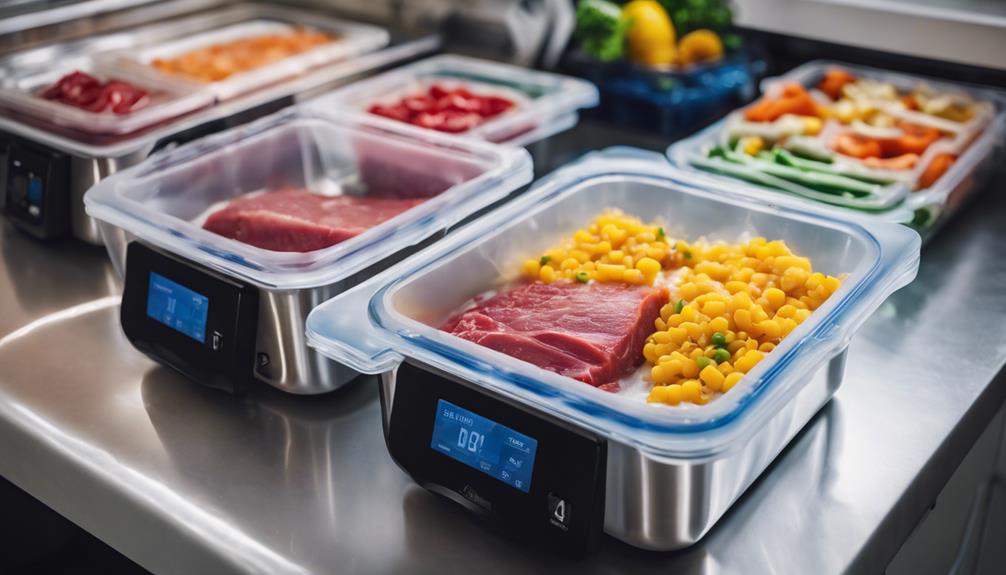
When you're planning your meals, you've got options with sous vide: you can cook first and freeze or freeze raw meat to cook later.
Cooking before freezing offers benefits like improved safety and flavor, while freezing raw gives you flexibility in meal prep.
Understanding these methods can help you make the most of your time and ingredients, ensuring delicious results every time.
Cooking First Benefits
Cooking meat before freezing it enhances flavor and tenderness, making meal prep quicker and more convenient. By using the sous vide method, you guarantee that your meals aren't only delicious but also efficiently prepared for future enjoyment.
Here are some key benefits of cooking first:
- Enhanced Flavor: Sous vide cooking locks in juices and seasoning, creating a rich taste.
- Optimal Tenderness: Cooking at precise temperatures breaks down tough fibers, resulting in fork-tender meat.
- Quick Meal Planning: With meals prepped in advance, you can easily grab and reheat for last-minute meals.
After cooking, a quick chill in an ice bath preserves the texture and keeps your meals safe from bacterial growth. Plus, sous vide cooked meats can be stored in the refrigerator for weeks or frozen for up to six months without losing quality.
This method not only retains the integrity of your food but also revolutionizes your cooking experience. Embracing cooking first with sous vide allows you to save time and enjoy perfectly sized meals whenever you need them.
Freezing First Advantages
Freezing meat before sous vide cooking offers unique advantages that enhance flavor, simplify meal prep, and promote efficient portion control.
By choosing freezing first, you preserve the meat's natural juices, which enhances both flavor and texture, especially for tougher cuts that thrive on longer cooking times. This method allows you to skip thawing, streamlining meal planning, so your food items are ready to eat quickly.
When you cook meat from frozen, just remember to add about 60 minutes to the cooking time to guarantee the meat reaches the desired temperature throughout. This approach also supports portion control, as you can prep individual servings in advance, making them easily accessible whenever you need them.
Using freezing first not only keeps your meals organized but also extends the shelf life of your meats, reducing food waste. It's a practical strategy that aligns perfectly with the goals of efficient meal planning.
Embracing sous vide cooking in this way allows you to enjoy well-cooked, flavorful meals without the hassle of daily preparation. So, consider freezing first to elevate your cooking experience while maintaining control over your portions.
Meal Prep Flexibility
Sous vide cooking offers you the flexibility to choose between fully preparing meals in advance or freezing raw ingredients for quick cooking later. This method allows you to control your meal prep strategy based on your schedule and preferences, ensuring you always have delicious, perfectly portioned meals ready to go.
Consider these options for maximizing your meal prep:
- Cook then Freeze: Ideal for tender cuts, this method maintains flavor and texture, perfect for reheating.
- Freeze then Cook: Great for tougher cuts, it requires adjusting cooking time but yields tender results.
- Quick-chill meals: Immerse cooked sous vide meals in an ice bath before freezing to preserve quality.
With sous vide, you can save time during busy weeks and create last-minute meals without compromising quality.
Remember, when cooking from a frozen state, add about 60 minutes to your cooking time to achieve the desired doneness.
Whether you're preparing food ahead or cooking on the fly, sous vide gives you innovative options to meet your meal prep needs.
Reheating Sous Vide Meals
Reheating sous vide meals requires careful attention to temperature and timing to preserve their delicious texture and flavor. To achieve perfect results, follow these guidelines for reheating your meals.
| Reheating Factor | Recommendation |
|---|---|
| Temperature | Use original cooking temperature (130°F to 140°F) |
| Thawing | Thaw in the refrigerator for 24 hours prior to reheating |
| Heating Time | Reheat for about one hour per inch of thickness |
| Post-Reheat Prep | Pat meat dry before searing for better browning |
When reheating, always verify the sous vide meals are vacuum-sealed to maintain quality. This method not only protects the food from freezer burn but also allows for convenient reheating options. By following these steps, you can confirm that your meals are heated evenly and safely, reducing the risk of bacterial growth. Remember, patience is key. Allow adequate time for reheating to prevent overcooking. With these practices, you'll enjoy perfectly reheated sous vide meals that are just as satisfying as when they were first cooked.
Essential Equipment for Success
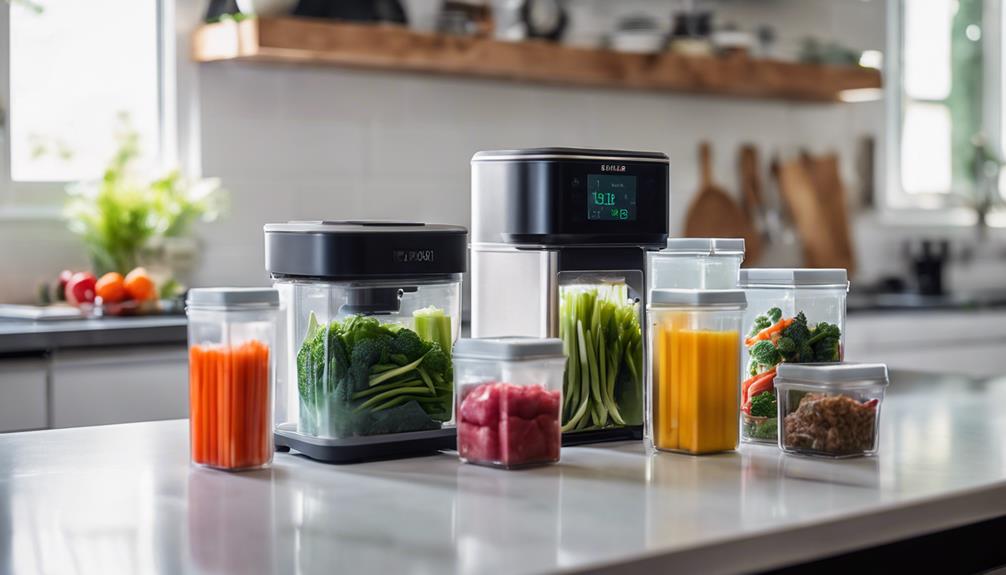
To achieve success with sous vide cooking, you'll need some essential tools to get started.
A precision sous vide cooker and quality vacuum-sealable bags are must-haves for ensuring precise temperature control and even cooking.
Additionally, a food scale and digital thermometer can help you maintain portion control and achieve the perfect doneness for your meals.
Must-Have Sous Vide Tools
Investing in essential sous vide tools, like a reliable immersion circulator and a vacuum sealer, sets you up for cooking success with perfectly controlled portions and flavors. These tools enhance your cooking experience, guaranteeing that you achieve the desired results every time.
Here are some must-have sous vide tools for your kitchen:
- Immersion Circulator: A device like the Anova Precision Cooker guarantees precise temperature control, ensuring evenly cooked meals.
- Vacuum Sealer: This machine removes air from bags, preventing oxidation and freezer burn, which preserves the quality and taste of your meals.
- Reusable Silicone Bags: Eco-friendly and sustainable, these bags make portion control easy and are perfect for meal planning.
With these essential tools, you'll streamline your meal prep and elevate your sous vide cooking. The combination of temperature control and effective portioning helps you enjoy delicious, healthy meals while embracing innovative cooking techniques.
Invest wisely, and watch your culinary skills flourish!
Choosing Quality Sous Vide Bags
Having the right sous vide tools sets the stage for success, and choosing quality sous vide bags is just as important for achieving perfectly cooked meals. When diving into sous vide cooking, you'll encounter various options, such as BPA-free plastic bags, vacuum-sealing bags, and reusable silicone sous vide bags. Each material offers unique benefits, including temperature resistance and durability, which are essential for effective cooking.
For best results, focus on vacuum-sealing bags designed specifically for sous vide. These bags eliminate air, reducing freezer burn and guaranteeing even cooking. Look for thicker bags; they provide better durability, heat retention, and leak prevention.
If you're keen on sustainability, consider reusable silicone sous vide bags. They're eco-friendly and dishwasher-safe, making them a smart choice for meal prepping.
Additionally, verify that the bags you select are compatible with your sealing method—some work with manual sealing, while others are tailored for vacuum sealers. By prioritizing quality sous vide bags, you set yourself up for culinary success, allowing you to create delicious, perfectly-sized meals with ease.
Tips for Meal Planning
Meal planning becomes a breeze when you batch cook recipes that can be easily portioned and reheated throughout the week. By incorporating effective cooking techniques, you can create meals that not only taste great but also assist with portion control. Here are some tips to elevate your meal prep game:
- Plan around your schedule: Select recipes that fit your week, guaranteeing you have ready-to-eat meals.
- Utilize seasonal produce: Shop at your grocery store for fresh ingredients, maximizing flavor while keeping costs down.
- Measure and vacuum seal: Use a food scale to portion out meals before vacuum sealing them, allowing precise calorie control and reducing waste.
Creating a meal prep calendar can help you decide which proteins and sides to cook each week. This strategy not only optimizes your sous vide machine's efficiency but also guarantees you're making the most of your ingredients.
With these tips, you'll master meal planning and enjoy perfectly sized, delicious meals all week long.
Frequently Asked Questions
What Are the Disadvantages of Sous Vide Cooking?
Sous vide cooking has drawbacks like high equipment costs, significant time investments, and a steep learning curve. You might also notice texture changes and reduced flavor intensity, raising safety concerns if precise techniques aren't mastered.
What Is the Critical Control Point for Sous Vide?
The critical control point for sous vide cooking is ensuring temperature regulation and proper cooking time. You can enhance sous vide safety through vacuum sealing, which also aids flavor infusion and prevents bacterial growth during food preservation.
Does Size Matter in Sous Vide?
Yes, size matters in sous vide. By focusing on portion sizes, you gain cooking precision, enhance flavor, guarantee food safety, and achieve nutritional balance—key benefits for innovative meal planning and preparation that elevates your culinary experience.
How Do You Weigh Food Down in Sous Vide?
To weigh food down in sous vide, use food weights or the water displacement method while vacuum sealing. This guarantees proper cooking time, enhances flavor infusion, and helps maintain portion sizes during your innovative meal prep.
Conclusion
Incorporating sous vide into your meal prep can streamline portion control and enhance your cooking experience.
By understanding the basics and selecting the right ingredients, you can create perfectly sized meals that are both flavorful and nutritious.
With the right equipment and techniques, you'll find reheating and enjoying your meals is easy.
Embrace this method for a more efficient way to manage your diet, ensuring you always have delicious, portion-controlled meals ready to go.
